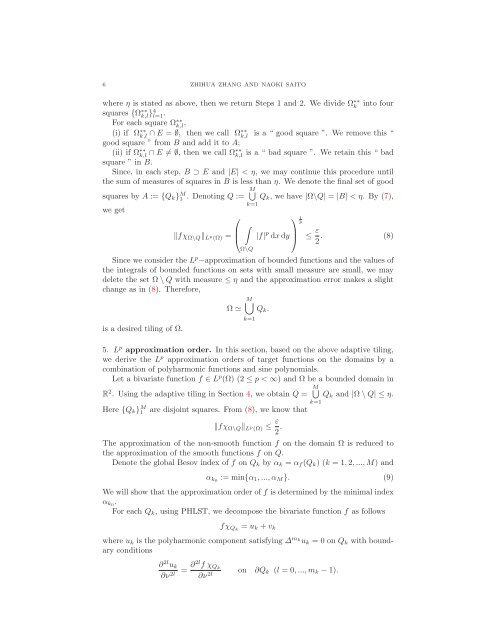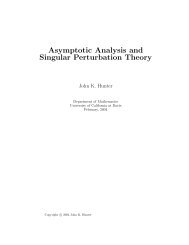PHLST WITH ADAPTIVE TILING AND ITS APPLICATION TO ...
PHLST WITH ADAPTIVE TILING AND ITS APPLICATION TO ...
PHLST WITH ADAPTIVE TILING AND ITS APPLICATION TO ...
You also want an ePaper? Increase the reach of your titles
YUMPU automatically turns print PDFs into web optimized ePapers that Google loves.
6 ZHIHUA ZHANG <strong>AND</strong> NAOKI SAI<strong>TO</strong><br />
where η is stated as above, then we return Steps 1 and 2. We divide Ω ∗∗<br />
k<br />
into four<br />
squares {Ω ∗∗<br />
k,l }4 l=1 .<br />
For each square Ω ∗∗<br />
k,l ,<br />
(i) if Ω ∗∗<br />
k,l<br />
∩E = ∅, then we call Ω∗∗<br />
k,l<br />
is a “ good square ”. We remove this “<br />
good square ” from B and add it to A;<br />
(ii) if Ω ∗∗<br />
k,l<br />
∩E ≠ ∅, then we call Ω∗∗<br />
k,l<br />
is a “ bad square ”. We retain this “ bad<br />
square ” in B.<br />
Since, in each step, B ⊃ E and |E| < η, we may continue this procedure until<br />
the sum of measures of squares in B is less than η. We denote the final set of good<br />
squares by A := {Q k } M 1 . Denoting Q := M ⋃<br />
Q k , we have |Ω\Q| = |B| < η. By (7),<br />
we get<br />
‖fχ Ω\Q ‖ Lp (Ω) =<br />
⎛<br />
⎜<br />
⎝<br />
k=1<br />
∫<br />
Ω\Q<br />
⎞<br />
|f| p ⎟<br />
dxdy⎠<br />
1<br />
p<br />
≤ ε 2 . (8)<br />
Since we consider the L p −approximation of bounded functions and the values of<br />
the integrals of bounded functions on sets with small measure are small, we may<br />
delete the set Ω\Q with measure ≤ η and the approximation error makes a slight<br />
change as in (8). Therefore,<br />
M⋃<br />
Ω ≃ Q k .<br />
is a desired tiling of Ω.<br />
k=1<br />
5. L p approximation order. In this section, based on the above adaptive tiling,<br />
we derive the L p approximation orders of target functions on the domains by a<br />
combination of polyharmonic functions and sine polynomials.<br />
Let a bivariate function f ∈ L p (Ω) (2 ≤ p < ∞) and Ω be a bounded domain in<br />
R 2 . Using the adaptive tiling in Section 4, we obtain Q = M ⋃<br />
Q k and |Ω\Q| ≤ η.<br />
Here {Q k } M 1 are disjoint squares. From (8), we know that<br />
‖fχ Ω\Q ‖ Lp (Ω) ≤ ε 2 .<br />
The approximation of the non-smooth function f on the domain Ω is reduced to<br />
the approximation of the smooth functions f on Q.<br />
Denote the global Besov index of f on Q k by α k = α f (Q k ) (k = 1,2,...,M) and<br />
k=1<br />
α k0 := min{α 1 ,...,α M }. (9)<br />
We will show that the approximation order of f is determined by the minimal index<br />
α k0 .<br />
For each Q k , using <strong>PHLST</strong>, we decompose the bivariate function f as follows<br />
fχ Qk = u k +v k<br />
where u k is the polyharmonic component satisfying ∆ m k<br />
u k = 0 on Q k with boundary<br />
conditions<br />
∂ 2l u k<br />
∂ν 2l = ∂2l f χ Qk<br />
∂ν 2l<br />
on ∂Q k (l = 0,...,m k −1).
















